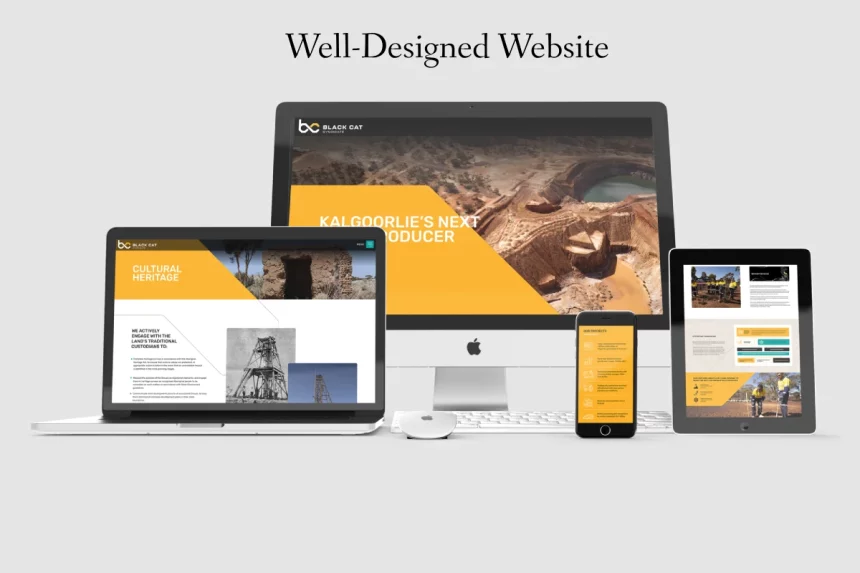The importance of a well-designed website cannot be overstated. As businesses try to stand out in the cluttered digital arena, website design goes beyond aesthetics to encompass a seamless user experience, trust development, brand perception improvement, and success.

A website is often the initial point of contact between a business and its potential clients in today’s digitally focused world. It serves as a digital storefront, displaying the brand’s credibility, values, and products. A well-designed website can be a potent weapon for enticing and involving visitors, producing a lasting impression that motivates them to explore further and become devoted customers.
The best web design London agencies can help your business embrace user-centric design and best practices, build strong customer relationships, encourage brand loyalty, and succeed in the digital age.
Why Website Design Matters
The Role of First Impressions
First impressions can make or break a user’s experience on a website quickly. Visitors create first impressions of a website within a few seconds of arriving at it based on its layout, visual attractiveness, and design. A compelling and well-designed website may make a favorable and lasting impression, capturing visitors’ attention and enticing them to explore deeper.
Color schemes, typography, and other website design components can trigger particular feelings and connections. A clean, contemporary layout projects professionalism, whereas a cluttered, outmoded layout could suggest disarray and a lack of credibility. A deliberate design that aligns with the brand’s message and target market can lay a solid groundwork for favorable user perception.
User Experience and Navigation
A website’s user experience (UX) dramatically influences how users interact with it. Users can easily access information, browse across sites, and carry out required actions when the user experience (UX) is smooth. An easy and seamless user experience is the primary goal of a well-designed website, increasing user pleasure and adherence.
Clear menu architecture, accessible search bars, and logical content organization are all essential for user-friendly navigation. Users are guided through the site by clear symbols and labels, making the information they want accessible. By removing obstacles to navigation, site users are more inclined to stick around and explore more. A well-structured and user-friendly website can decrease bounce rates, which refers to users leaving a website without interacting further.
Building Trust and Credibility
The credibility of a website is primarily influenced by its design. A trustworthy feeling is created by a professional and aesthetically pleasing design, demonstrating the legitimacy and dependability of the company. On the other hand, a well-designed website can cast doubt on the caliber of the goods or services provided.
Credibility is increased by visual cues, including crisp photos, expertly crafted logos, and accreditation certificates. Client testimonials and reviews also facilitate building trust.
Moreover, a well-designed website supports a favorable brand perception. Brand awareness is facilitated, and the brand’s values and message are reinforced by maintaining consistency in branding elements, color palettes, and visual identity throughout the website. A polished and unified design improves brand recognition, which increases client loyalty.
Mobile Responsiveness and Accessibility
Mobile responsiveness is essential since more and more people are using mobile devices to access the internet. A well-designed and optimized website for mobile devices can automatically adjust to various screen sizes, offering a consistent user experience regardless of the device being used.
Mobile responsiveness improves customer happiness by enabling users to access information without the need for frequent zooming or scrolling. A good mobile experience motivates consumers to stay on the website longer, increasing engagement and conversion rates.
Moreover, all users, including those with disabilities, may easily explore and access material thanks to an accessible website design. Features that increase inclusivity and cater to a broader range of consumers include keyboard navigation, movie subtitles, and alt-text for photos.
Branding and Visual Identity
A well-designed website complements the mission, target market, and guiding principles of the business. Colors, fonts, and artwork should complement the brand’s personality and convey its distinctive character.
Brand recognition is strengthened by the website’s consistent use of brand aspects. Visitors are likelier to remember and be loyal to a business when they come across recognizable colors, logos, and design features.
Building a strong brand image is helped by a website design that is unified and consistent. Maintaining a consistent visual presentation across all sites and marketing materials creates a sense of professionalism and dependability.
SEO and Rankings
The effectiveness of a site’s search engine optimization (SEO) is directly impacted by its website design. Search engines consider elements such as site structure, loading time, and mobile friendliness when evaluating search ranks.
Search engines like Google give mobile-friendly websites preference in mobile search results. In addition to improving user experience, a mobile-friendly design improves SEO rankings for mobile searches.
A website’s SEO-friendly design will include clear code, optimized imagery, and quick loading speeds. Following SEO best practices ensures that search engines can efficiently crawl and index the website.
Conversion Rate Optimization
Conversion rates are significantly influenced by website design. A well-designed website that leads visitors through the conversion funnel with obvious CTAs and simple forms increases the possibility of conversion.
However, CTA button placement, copywriting, and aesthetic appeal influence user behavior and conversions. Design components encouraging users to take desired actions increase the website’s effectiveness.
Businesses can use A/B testing to evaluate various design components and identify which modifications result in higher conversion rates. The website is optimized for maximum conversion rates using data-driven design choices based on user behavior and preferences.
Conclusion
A well-designed website is more than simply about aesthetics; it’s a calculated investment affecting many aspects of a company’s performance.
Businesses can create a transformative online presence that enthralls visitors, drives engagement, and results in remarkable business growth by understanding the importance of first impressions, prioritizing user experience and navigation, establishing trust and credibility, ensuring mobile responsiveness and accessibility, aligning design with branding, optimizing for SEO, and embracing conversion rate optimization. Website design is crucial for surviving in the cutthroat digital era because it influences user perception and overall success in the digital field.


